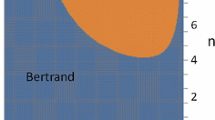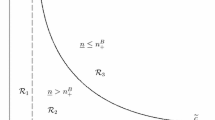Abstract
We report on an experiment conducted to evaluate the effects of varying the way in which market information is presented to participants in laboratory Cournot duopolies. We find that the most standard variations, which are the use of a profit table or a profit calculator, yield indistinguishable performance. However, the addition of a best-response option to the profit calculator tends to increase aggregate output to the Cournot level and decrease the incidence of tacit collusion.
Similar content being viewed by others
References
Altavilla, C., Luini, L., & Sbriglia, P. (2006). Social learning in market games. Journal of Economic Behavior and Organization, 61, 632–652.
Beil, R. O. (1988) Collusive behavior in experimental oligopoly markets. PhD thesis, Texas A&M.
Bigoni, M. (2010). What do you want to know? Information acquisition and learning in experimental Cournot games. Research in Economics, 64, 1–17.
Binger, B. R., Hoffman, E., & Libecap, G. D. (1991). Experimental methods to advance historical investigation: an examination of cartel compliance by large and small firms. In J. Mokyr (Ed.), The vital one: essays in honor of Jonathan R.T Hughes, Research in Economic History, Supplement 6, pp. 309–324.
Bosch-Doménech, A., & Vriend, N. J. (2003). Imitation of successful behavior in Cournot markets. Economic Journal, 113, 495–524.
Bru, L., Gomez, R., & Ordonez, J. M. (2002). Information in repeated experimental Cournot games. In R. M. Isaac & C. A. Holt (Eds.), Experiments investigating market power (pp. 191–215). Amsterdam: JAI/Elsevier.
Cason, T. N., & Mason, C. F. (1999). Information sharing and tacit collusion in laboratory duopoly markets. Economic Inquiry, 37, 258–281.
Cox, J. C., & Walker, M. (1998). Learning to play Cournot duopoly strategies. Journal of Economic Behavior and Organization, 36, 141–161.
Daughety, A. F., & Forsythe, R. (1987a). The effects of industry-wide price regulation on industrial organization. Journal of Law, Economics, and Organization, 3, 397–434.
Daughety, A. F., & Forsythe, R. (1987b). Industrywide regulation and the formation of reputations: a laboratory analysis. In E. E. Bailey (Ed.), Public regulation: new perspectives on institutions and policies (pp. 347–398). Cambridge: MIT Press.
Davis, D. D., Reilly, R. J., & Wilson, B. (2003). Cost structures and Nash play in repeated Cournot games. Experimental Economics, 6, 209–226.
Duersch, P., Kolb, A., Oechssler, J., & Schipper, B. (2010). Rage against the machines: how subjects play against learning algorithms. Economic Theory, 43, 407–430.
Feltovich, N. (2003). Nonparametric tests of differences in medians: comparison of the Wilcoxon-Mann-Whitney and Robust rank-order tests. Experimental Economics, 6, 273–297.
Fischbacher, U. (2007). z-Tree: Zurich toolbox for ready-made economic experiment. Experimental Economics, 10, 171–178.
Fligner, M. A., & Policello, G. E. (1981). Robust rank procedures for the Behrens-Fisher problem. Journal of the American Statistical Association, 76, 162–168.
Fonseca, M., Huck, S., & Normann, H. T. (2005). Playing Cournot although they shouldn’t. Economic Theory, 25, 669–677.
Fonseca, M., Müller, W., & Normann, H. T. (2006). Endogenous timing in duopoly: experimental evidence. International Journal of Game Theory, 34, 443–456.
Fouraker, L., & Siegel, S. (1963). Bargaining behavior. New York: McGraw-Hill.
Hoggatt, A. C. (1959). An experimental business game. Behavioral Science, 4, 192–203.
Holcomb, J. H., & Nelson, P. S. (1997). The role of monitoring in duopoly market outcomes. Journal of Socio-Economics, 79–93.
Holt, C. A. (1985). An experimental test of the consistent-conjectures hypothesis. American Economic Review, 75(3), 314–325.
Huck, S. (2004). Oligopoly. In D. Friedman & A. Cassar (Eds.), Economics lab: an intensive course in experimental economics (pp. 105–114). London: Routledge.
Huck, S., & Wallace, B. (2002). Reciprocal strategies and aspiration levels in a Cournot-Stackelberg experiment. Economics Bulletin, 3, 1–7.
Huck, S., Normann, H. T., & Oechssler, J. (1999). Learning in Cournot oligopoly—an experiment. Economic Journal, 109, 80–95.
Huck, S., Normann, H. T., & Oechssler, J. (2000). Does information about competitors’ actions increase or decrease competition in experimental oligopoly markets? International Journal of Industrial Organization, 18, 39–57.
Huck, S., Müller, W., & Normann, H. T. (2001). Stackelberg beats Cournot: on collusion and efficiency in experimental markets. Economic Journal, 111, 749–765.
Huck, S., Müller, W., & Normann, H. T. (2002a). To commit or not to commit: endogenous timing in experimental duopoly markets. Games and Economic Behavior, 38, 240–264.
Huck, S., Normann, H. T., & Oechssler, J. (2002b). Stability of the Cournot process: experimental evidences. International Journal of Game Theory, 31, 123–136.
Huck, S., Normann, H. T., & Oechssler, J. (2004). Two are few and four are many: number effects in experimental oligopolies. Journal of Economic Behavior and Organization, 53, 435–446.
Huck, S., Konrad, K. A., Müller, W., & Normann, H. T. (2007). The merger paradox and why aspiration levels let it fail in the laboratory. Economic Journal, 117, 1073–1095.
Le Coq, C., & Orzen, H. (2006). Do forward markets enhance competition? Experimental evidence. Journal of Economic Behavior and Organization, 61, 415–431.
Mason, C. F., & Phillips, O. R. (1997). Information and cost asymmetry in experimental duopoly markets. Review of Economics and Statistics, 79, 290–299.
Mason, C. F., Phillips, O. R., & Redington, D. B. (1991). The role of gender in a non-cooperative game. Journal of Economic Behavior and Organization, 15, 215–235.
Mason, C. F., Phillips, O. R., & Nowell, C. (1992). Duopoly behavior in asymmetric markets: an experimental evaluation. Review of Economics and Statistics, 74, 662–670.
Müller, W. (2006). Allowing for two production periods in the Cournot duopoly: experimental evidence. Journal of Economic Behavior and Organization, 60, 100–111.
Oechssler, J., & Schuhmacher, F. (2004). The limited liability effect in experimental duopoly markets. International Journal of Industrial Organization, 22, 163–184.
Offerman, T., Potters, J., & Sonnemans, J. (2002). Imitation and belief learning in an oligopoly experiment. Review of Economic Studies, 63, 973–997.
Pantz, K., & Ziegelmeyer, A. (2005). Collaborative networks in experimental triopolies. Papers on Strategic Interaction 2005-38, Max Planck Institute of Economics.
Potters, J., & Suetens, S. (2009). Cooperation in experimental games of strategic complements and substitutes. Review of Economic Studies, 76, 1125–1147.
Raab, P., & Schipper, B. C. (2009). Cournot competition among teams: an experimental study. Journal of Economic Behavior and Organization, 72, 691–702.
Rassenti, S., Reynolds, S. S., Smith, V. L., & Szidarovszky, F. (2000). Adaptation and convergence of behavior in repeated experimental Cournot games. Journal of Economic Behavior and Organization, 41, 117–146.
Saijo, T., & Nakamura, H. (1995). The spite dilemma in voluntary contribution mechanism experiments. Journal of Conflict Resolution, 39, 535–560.
Selten, R., & Ostmann, A. (2001). Imitation equilibrium. Homo Oeconomicus, 18, 111–149.
Selten, R., & Sauermann, H. (1959). Ein Oligopolexperiment. Zeitschrift für die gesamte Staatwissenschaft, 115, 427–471.
Waichman, I., Requate, T., & Siang, C. K. (2010). A Cournot experiment with managers and students: evidence from Germany and Malaysia. The BE Journal of Economic Analysis and Policy (Topics) 10, Article 30.
Author information
Authors and Affiliations
Corresponding author
Electronic Supplementary Material
Below is the link to the electronic supplementary material.
Rights and permissions
About this article
Cite this article
Requate, T., Waichman, I. “A profit table or a profit calculator?” A note on the design of Cournot oligopoly experiments. Exp Econ 14, 36–46 (2011). https://doi.org/10.1007/s10683-010-9256-2
Received:
Accepted:
Published:
Issue Date:
DOI: https://doi.org/10.1007/s10683-010-9256-2




